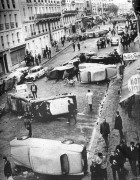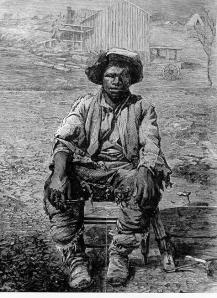In the summer of 2012, I ended up in New Haven to take a couple of courses at Yale. There I engaged in a month of vigorous history reading that culminated with my desire to attempt a systematic historiography. I resolved to write about Gabriel’s Rebellion. I had intended simply to trudge through a handful of full length treatments and a dozen or so articles before arriving at a somewhat predictable conclusion. I didn’t think I would find a juicy narrative to toy out but I was sorely mistaken. I found immediately that Gabriel Prosser’s story is more complicated than “a failed slave rebellion resulting in 25 executed slaves.” To start, he never took the name of his owner, “Prosser.”
During the summer of 1800, Thomas Prosser’s Gabriel plotted the overthrow of white Virginia. Thomas Prosser, Gabriel’s owner, had a blacksmith shop on his plantation, so it may have been unnecessary to hire Gabriel out to Richmond. Nonetheless, Prosser’s slaves and many others in the region had excellent freedom of movement, especially on the weekends. They could visit relatives, dance in the woods, attend church meetings, and evidently plot rebellions.[1] Gabriel’s plan was relatively simple but required hundreds, if not thousands, of willing participants. He proposed a march on Richmond, where the army would burn some of the town to the ground and capture the state’s armory which resided in the capitol building. His co-conspirators traveled to several other counties recruiting participants and Gabriel rewarded them with commanding positions if they convinced enough men to join. The leaders of the rebellion, stationed on their plantation just outside of Richmond, never appeared to fully grasp how many men would come when they finally proposed August 30th as the date the rebellion was to take place. Prosser’s Ben testified that Gabriel said he had “nearly all the Negroes in town” but estimates of the true force ranged from 600 to 10,000.[2]
On the day of the plot, two slaves named Tom and Pharaoh revealed the conspiracy to their owner, Mosby Sheppard. He warned his neighbors and Governor James Monroe soon knew of the potential uprising. That evening, a storm of Biblical proportions beset Virginia and the plotters decided to postpone their insurrection until the next day. By that time, it was already too late. The slave state formed its militias and quickly began arresting slaves in Henrico County, where the Gabriel lived. The leader himself eluded capture for a time, but authorities eventually arrested him in Norfolk. The plot had failed, leaving Gabriel and twenty-five of his co-conspirators hanged by the state of Virginia. Another slave, Jacob, apparently committed suicide while he resisted arrest. Despite its failure, the attempted rebellion sent shockwaves through the slaveholding South, as planters grew suspicious of their human capital (more on that in a later post).
I started my research by reading Douglas Egerton’s Gabriel’s Rebellion, which was written in 1993 and serves as most professional historians’ preferred narrative on the uprising. At the core of Egerton’s work is the concept that Gabriel was an “artisanal republican” and a “black Jacobin” because of his literacy, skill as a blacksmith, and work in the budding city of Richmond. Egerton argues that those historians who came before him did not grasp the connection between Gabriel and the larger public sphere, which Egerton claims Gabriel was a participant in. The narrative of Gabriel’s Rebellion is strong and concedes little room for alternative interpretations of the evidence. In an effort to keep his story clean, Egerton often treats his own speculative extrapolations as fact, preferring to discuss their controversy in his notes.[3] His conclusions, however, have been addressed by Michael Nicholls in his new book on Gabriel’s Revolt titled Whispers of Rebellion.
Nicholls follows in Egerton’s footsteps as he traces Gabriel’s rebellion from conception to conclusion, interpreting the evidence from a new perspective and offering clarification of some of Egerton’s more glaring missteps. In so doing, Nicholls reveals the nature of Egerton’s historiographic stretches. In many instances, Egerton reaches beyond the support of evidence and documentation and gives Gabriel perhaps more agency than he actually possessed. This may have been a symptom of the broad effort by historians to correct the racially charged interpretations of scholars like William Palmer that Gabriel and his followers were simply misguided, unintelligent slaves. Furthermore, it indicates that Egerton was aware of the development of scholarship surrounding Thomas Jefferson’s “influence on the formation of working class radicalism” as he was among the first historians to attempt to apply that spirit to the artisan slave community.[4] From a simple reading of Egerton’s work, it would seem that he accomplished this goal soundly. He placed Gabriel in Richmond, working as a blacksmith and absorbing the artisanal community therein, attributing an impressive literacy to the enslaved leader.[5] Egerton also put Gabriel in contact with two French sympathizers who acted as a Democratic-Republican capstone.[6] Taken together, Gabriel was a quintessential artisanal republican, but Nicholls raises serious doubts about the legitimacy of Egerton’s claims.
Nicholls addresses Egerton’s first claim that Gabriel worked and interacted with others in Richmond. Egerton claims, “Even with all the potential work to be done at Brookfield, Gabriel spent more than a few days each month smithing in and around Richmond.”[7] When one traces his footnote here, he offers no citation for that conclusion. Nicholls notes that Egerton plods further from that foundation, as he argues, “Gabriel imbibed his artisan republicanism from other white and black artisans while self-hired in Richmond.”[8] Lacking any evidence, Egerton claims that Prosser allowed Gabriel to hire himself out in Richmond, and while he worked he subscribed to republicanism. While Gabriel possibly met artisans when he visited Richmond to purchase supplies on Sundays, there is no evidence their philosophy fueled his rebellion.[9]
Egerton builds evidence for his republican Gabriel by deeply investigating his relationship with the “two Frenchmen” who became infamous for their alleged support of the rebellion. There is little substantive evidence that either of the men that Egerton identified as being unseen co-conspirators were even remotely aware that the rebellion existed. Charles Quersey “frequently advised him and several other Negroes, to rise and kill the White People” in 1796, according to Gilbert, a chief recruiter in Gabriel’s army. Despite the fact that Gilbert had not seen him since 1796, Egerton believes that Quersey was the “Man from Caroline who was at the Siege of York-Town” and would lead the military invasion of Richmond. However, Nicholls found that Quersey left Caroline in 1797 and disappeared from the record permanently in 1799.[10] No testimony or documentation exists definitively connecting Quersey to the rebellion. Similarly, Egerton implicated Alexander Beddenhurst with tenuous evidence. None of the slaves ever mention Beddenhurst in their testimony (though Egerton mistakenly claims that Gilbert did), so the only evidence of his involvement came from a “bitterly partisan account of the aborted uprising published in the Fredericksburg Virginia Herald on 23 September 1800.”[11]
The supposed involvement of the Frenchmen in the plot allowed Egerton to claim that Gabriel led an artisan republican revolt inspired by the French Revolution. Gabriel contradicted that claim by saying that the slaves must “conquer the white people” and “slay them as we go” while sparing only “the females of all ages.” Only co-conspirator Ben Woolfolk hinted at a coalition that included whites. “I understand all the Whites were to be massacred except the Quakers, the Methodists and the French men,” he testified.[12] The extent of the rebellion’s awareness of a French allegiance is found in that singular statement. Any further correlation that Egerton claimed was not based on sound evidence.
The more contemporary account offered by Egerton was the first full-length treatment of the uprising, aiming to bring a modern, objective voice to the historiographical debate. It failed to do so when Egerton imagined Gabriel as an artisanal republican despite a dearth of evidence. The conclusions Egerton reaches are not far beyond reasonable speculation. However, he should have presented them outside his more fact-driven narrative, separating objective fact from mere guesswork. Nicholls’ account sheds, and is conscious of, the various political aspirations of the interpretations offered by other historians. Gabriel’s true motives will never be fully ascertained, but historians’ speculations form a history their own.
Perhaps I was naïve or simply misguided, but the breadth of this historical debate shocked me. I did not imagine that historians felt they could take such liberty with source material, and I began to question the decade of historical learning that had always treated some elements of historical narrative as fact. “History is a debate” I was always told, tongue-in-cheek. It seemed like, though, that the big questions had already been answered. Only the greatest men could affect the motions of history:
Who won our independence? George Washington with his Continental Army! (Wait, the French were involved?) Who freed the slaves? Abraham Lincoln and his Emancipation Proclamation! (Did the slaves free themselves?)
The more we as historians and Americans seize on these great moments and assert the agency of average people, the more useful our historical memory will be for “average” students and future generations. I applaud Michael Nicholls for carefully crafting a narrative of Gabriel as a man with whom we can all relate. It was not some fearsome French Jacobin outlier who led a slave uprising that nearly crippled the state of Virginia. It was just a man, a man named Gabriel who wanted to be free.
-Zack Quaratella
[1] Gerald Mullin, Flight and Rebellion: Slave Resistance in 18th Century Virginia (Oxford: Oxford University Press, 1972) 143.
[2] Michael Nicholls, Whispers of Rebellion: Narrating Gabriel’s Conspiracy (Charlottesville: University of Virginia Press, 2012) 40.
[3] Graham Russell Hodges, “Gabriel’s Republican Revolution,” Reviews in American History 22, no. 3 (September 1994): 428.
[4] Ibid., 428.
[5] Douglas Egerton, Gabriel’s Rebellion: The Virginia Slave Conspiracies of 1800 and 1802 (Chapel Hill: North Carolina Press, 1993) 24.
[6] Ibid., 67.
[7] Ibid., 24.
[8] Nicholls, Whispers of Rebellion, 97.
[9] Ibid., 97.
[10] Ibid., 44.
[11] Egerton, Gabriel’s Rebellion, 67; Nicholls, Whispers of Rebellion, 189.
[12] Nicholls, 38.




yeah yale!
Thanks, Sarah!
Did the slaves free themselves? [This question haunted me after reading this post.]
There’s an interesting (and burgeoning) historiographical debate around that very question. For generations, historians assumed that while the Emancipation Proclamation did not free any slaves immediately when it was issued, it eventually paved the way for the 13th, 14th, and 15th amendments and the permanent abolition of slavery. Robert Engs (who actually worked at the College briefly) argued that the slaves freed themselves by deserting the plantations en masse during the Civil War, forcing the Union to confront the issue. A great example of this is summed up nicely in this article: http://articles.dailypress.com/2011-09-24/features/dp-nws-fort-monroe-contrabands-20110924_1_slaves-shepard-mallory-freedom-s-first-generation. (Hope I did the html right.) Additionally, for a more scholarly discussion of the historiography by the leading Civil War historian of our era, see http://www.jstor.org/stable/986716.
Thanks for your question. Hopefully this debate that historians are having will give more people the thought that they can liberate themselves from whatever oppressive situation they’re faced with.
PS Do you know how to embed links?
Reblogged this on Moorbey'z Blog.